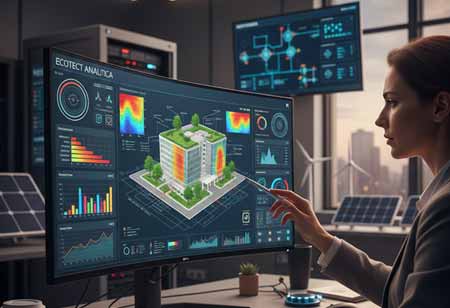CLOSE
Specials
I agree We use cookies on this website to enhance your user experience. By clicking any link on this page you are giving your consent for us to set cookies. More info
Be first to read the latest tech news, Industry Leader's Insights, and CIO interviews of medium and large enterprises exclusively from Energy Tech Review
Thank you for Subscribing
The Ascent of Energy Simulation Software in a Net-Zero Worlds
The energy simulation software market is rapidly growing, driven by Net-Zero goals and smart building mandates, and is poised to become a vital technology for efficient, sustainable design and operations by 2035.

By
Energy Tech Review | Wednesday, November 12, 2025
Stay ahead of the industry with exclusive feature stories on the top companies, expert insights and the latest news delivered straight to your inbox. Subscribe today.
The Asia-Pacific (APAC) energy simulation software market is not merely a quantitative surge; it's a qualitative transformation. Once a niche tool for specialists, this software is rapidly evolving into the central digital nervous system for the world's built environment. Driven by the unyielding global momentum toward Net-Zero emissions and the proliferation of smart building mandates, particularly across the rapidly urbanizing region, the market is poised to become one of the most critical technology sectors of the next decade, steering investment, design, and operations across construction, utilities, and industry.
The Twin Engines of Transformation: Decarbonization and Digitalization
The transition toward decarbonization stands as the primary catalyst for the growth of the energy simulation market. Governments and corporations worldwide have moved beyond setting aspirational climate goals and are now actively implementing strategies that require precise planning, verification, and accountability. In APAC, over 39 of 49 member states have made carbon neutrality and net-zero pledges, driving the urgent need for enabling frameworks and strategies.
Energy simulation software has emerged as the critical link between these ambitions and measurable outcomes. It enables the design of Net-Zero-Energy Buildings (nZEBs) and Net-Zero-Carbon Buildings (nZCBs) by allowing architects and engineers to simulate a building’s entire life-cycle energy performance before construction begins. Through detailed modeling, professionals can evaluate various design alternatives—ranging from insulation and glazing materials to orientation and system integration—to identify the most efficient, cost-effective pathways to carbon neutrality. Such tools are also indispensable for integrating renewable energy sources at scale, accurately simulating the performance of solar, wind, and geothermal systems, and optimizing energy storage and grid interaction to ensure a consistent, sustainable power supply.
In parallel, the global movement toward intelligent, connected infrastructure is reinforcing this momentum. Evolving regulatory frameworks—such as the Energy Performance of Buildings Directive (EPBD) in Europe and the push for stronger, mandatory building energy codes across APAC economies are imposing stringent requirements for energy efficiency and smart readiness in both new construction and major renovations. Compliance with these mandates necessitates advanced energy modeling capabilities. Smart buildings function as complex ecosystems of interconnected systems controlling HVAC, lighting, and security. Energy simulation software serves as the analytical core of these environments, enabling seamless coordination and optimization. By integrating real-time data from Internet of Things (IoT) sensors, these tools extend beyond static design to continuously optimize performance, anticipate energy needs, and respond to variables such as occupancy patterns, weather fluctuations, and grid demands.
The Platform Dual-Track: Cloud Agility vs. On-Premises Security
The market’s expansion is marked not only by its increasing scale but also by the versatility of its deployment models. Growth is progressing rapidly along two parallel paths—cloud-based and on-premises solutions—each serving a distinct yet complementary role within the broader ecosystem.
The shift toward cloud-based (SaaS) platforms represents the evolution in this space. Cloud solutions are driving accelerated adoption due to their unmatched accessibility, seamless collaboration capabilities, and vast computational capacity. By eliminating the need for significant upfront investments in high-performance hardware, cloud platforms democratize access to advanced simulation tools, enabling smaller engineering firms, architects, and consultants to leverage technologies once reserved for large enterprises. This accessibility not only broadens the user base but also fuels innovation across the industry. Cloud-based platforms foster real-time collaboration among geographically dispersed teams, a crucial advantage for multi-national construction projects common in the APAC region. Their virtually limitless computational resources further enhance efficiency, reducing simulation timelines from days to minutes through parallel processing capabilities.
At the same time, on-premises deployment continues to serve as a critical, resilient foundation for the market. Despite the growing dominance of cloud solutions, this model is expected to maintain a significant share through 2035, particularly among organizations prioritizing stringent data control and security. Government agencies, defense institutions, utilities, and large-scale industrial manufacturers often rely on on-premises systems to safeguard sensitive information within their internal networks. These environments function as secure “digital fortresses,” offering unmatched stability, control, and the ability to tailor configurations for specialized, mission-critical operations and long-term research initiatives.
The Technology Forging the Future
The rapid expansion of this market is driven by a wave of technological innovation that is transforming simulation tools into more powerful, predictive, and integrated systems. Among these advancements, Artificial Intelligence (AI) and Machine Learning (ML) stand out as the most significant. By embedding AI and ML algorithms directly into simulation software, these tools are evolving from static analytical systems into predictive engines. They can process vast amounts of real-time data to uncover subtle patterns in energy consumption, accurately forecast demand, and recommend targeted optimizations for systems such as HVAC and lighting.
A key development emerging from this technological evolution is the rise of digital twins—real-time, virtual replicas of physical assets such as buildings, power plants, or entire city grids. Continuously updated through data from IoT sensors, digital twins enable operators to simulate “what-if” scenarios, such as the effects of extreme weather or equipment upgrades, before implementing changes in the real world. This capability enhances operational efficiency, resilience, and decision-making precision. The deployment of digital twin technology is a core component of the numerous Smart City initiatives underway across APAC.
The integration of IoT and real-time data further strengthens this ecosystem. The widespread availability of affordable IoT sensors provides the data foundation necessary for these intelligent systems. By bridging the virtual and physical environments, real-time data integration ensures that simulations are no longer reliant on historical averages but instead reflect current conditions. This creates a continuous feedback loop that allows for more accurate, actionable insights and supports proactive facility management.
The applications and end-user base for energy simulation software are rapidly expanding beyond their original scope. The APAC market by 2035 will be fully integrated across design, and operations serving not merely as an economic signal, but as a measure of the world’s shift toward a more efficient, sustainable, and intelligent energy future.

Copyright © 2025 Energy Tech Review. All rights reserved






